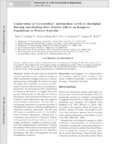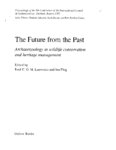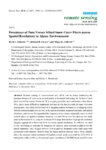1 - 25 of 18
| Creator | Title | Description | Subject | Date | ||
|---|---|---|---|---|---|---|
| 1 |
 |
Codding, Brian | Codding, Brian: Living outside the box: An updated perspective on diet breadth and sexual division of labor in the Prearchaic Great Basin [Author's Manuscript] | A tremendous amount has been learned about the Prearchaic (before 9000 BP) Great Basin since we advocated a perspective of sexual division of labor based on Human Behavioral Ecology a decade ago. Many investigators have taken our advice and a few have challenged our assumptions and inferences. One o... | 2014-01-01 | |
| 2 |
 |
Broughton, John | Size of the bursa of fabricius in relation to gonad size and age in laysan and black-footed albatrosses | Age determination can be difficult for birds that undergo little or no plumage change during life. This is the case for Laysan and Black-footed Albatrosses (Diomedea immutabilis and D. nigripes). The juvenile plumage for both these North Pacific albatrosses is completely grown by about five to six m... | Birds; Species; Development | 1994 |
| 3 |
 |
Codding, Brian | Conservation or co-evolution? Intermediate levels of aboriginal burning and hunting have positive effects on kangaroo populations in Western Australia | Studies of conservation in small scale societies typically portray indigenous peoples as either sustainably managing resources, or forsaking long-term sustainability for short-term gains. To explain this variability, we propose an alternative framework derived from a co-evolutionary perspective. In ... | 2014-01-01 | |
| 4 |
 |
Broughton, John | Fish remains dominate Barn Owl pellets in northwestern Nevada | The foraging ecology of the Barn Owl (Tytoalba) has been studied extensively, both in the New World (Marti 1988, Castro and Jaksic 1995, Van Vuren and Moore 1998, and others) and the Old World (Glue 1967, Yom-Tov and Wool 1997, and others). Small rodents, insectivores, and small birds are generally ... | Barn Owl pellets; Northwestern Nevada; Fish; Fish remains | 2006 |
| 5 |
 |
Broughton, John | Prehistoric human impacts on California birds: evidence from the Emeryville Shellmound Avifauna | The abundance of artiodactyls, marine mammals, waterfowl, seabirds, and other animals in 18th- and 19th-century California astonished early explorers, and the incredible wildlife densities reported in their accounts are routinely taken as analogues for the original or pristine zoological condition. ... | Avifauna; Prehistoric hunting; Biological evaluation of environmental impacts | 2004 |
| 6 |
 |
Hawkes, Kristen | Hadza scavenging: implications for Plio/Pleistocene Hominid subsistence | The frequent association of stone tools and large animal bones in African Plio/Pleistocene archaeological sites has long been taken as evidence of the importance of hunting in early hominid diets. Many now argue that it reflects hominid scavenging, not hunting. | Hadza; Scavenging; Plio/Pleistocene; Hominid Diet | 1988-04 |
| 7 |
 |
O'Rourke, Dennis H. | Introduction: origins and settlement of the indigenous populations of the Aleutian Archipelago | The series of papers in this special issue of Human Biology use an interdisciplinary approach to address regional questions and to integrate disparate Aleutian data into a broad, synthetic effort. The contributors leverage decades of data on Aleut origins, biogeography, and behavior through integrat... | 2010 | |
| 8 |
 |
Broughton, John | Pristine benchmarks and indigenous conservation? Implications from California zooarchaeology | The superabundance of tame wildlife during the early historic period in California astonished European explorers. And the historic accounts of incredible animal densities, most notably artiodactyls, have influenced a long-held perception that California Indians lived in harmony with nature. However,... | 2004-01-01 | |
| 9 |
 |
Broughton, John | Resource intensification and late Holocene human impacts on Pacific coast bird populations: evidence from the Emeryville shellmound avifauna | Anthropologists and conservation biologists have commonly assumed that the distributions and abundances of vertebrate resources recorded during the early historic period in North America reflected a "pristine" condition. This view follows from the perception that Native American population densities... | Resource intensification; Holocene human impacts; Foraging efficiency; Harvest pressure; Bird populations; Emeryville shellmound | 2001 |
| 10 |
 |
Cashdan, Elizabeth A. | Competition between foragers and food producers on the Botletli River, Botswana | The immigration of food-producing groups into areas occupied by hunters and gatherers must have been a common occurrence in prehistory. How were the hunter-gatherers affected by this? I describe here two groups of Kalahari Basarwa ('Bushmen'), one living along the flood plain of the lower Botletli ... | Kalahari Basarwa; Bushmen; Foraging; Cattle | 1986 |
| 11 |
 |
Forster, Richard R. | Prevalence of pure versus mixed snow cover pixels across spatial resolutions in alpine environments | Remote sensing of snow-covered area (SCA) can be binary (indicating the presence/absence of snow cover at each pixel) or fractional (indicating the fraction of each pixel covered by snow). Fractional SCA mapping provides more information than binary SCA, but is more difficult to implement and may no... | 2014-01-01 | |
| 12 |
 |
Li, Minqi | China: hyper-development and environmental crisis | China's spectacular economic growth has been one of the most dramatic developments in the global economy over the past quarter century. Between 1978 and 2004 the Chinese economy expanded at an annual rate of 9.4 per cent. No other large economy has ever grown so rapidly for so long in the economic h... | China; Economic growth; Environmental impacts | 2007 |
| 13 |
 |
McElreath, Richard | Can females gain additional paternal investment by mating with multiple males? a game theoretic approach | Although females may require only one mating to become inseminated, many female animals engage in costly mating with multiple males. One potential benefit of polyandrous mating is gaining parental investment from multiple males. We developed two game theoretic models to explore this possibility. Our... | Female multiple mating; Polyandry; Nonprocreative mating; Paternal investment; Mating benefits; Mating strategy | 2001-11 |
| 14 |
 |
O'Rourke, Dennis H. | South from Alaska: a pilot aDNA study of genetic history on the Alaska Peninsula and the Eastern Aleutians | Abstract The Aleutian Islands were colonized, perhaps several times, from the Alaskan mainland. Earlier work documented transitions in the relative frequencies of mtDNA haplogroups over time, but little is known about potential source populations for prehistoric Aleut migrants. As part of a pilot i... | 2010 | |
| 15 |
 |
Broughton, John | Terminal Pleistocene fish remains from Homestead Cave, Utah, and implications for fish biogeography in the Bonneville Basin | Eleven fish species were identified from Homestead Cave, Utah. The remains, concentrated in the lowest stratum of the deposit, were accumulated by owls between approximately 11,200 and 10,100 14C yr B.P. and likely represent fish associated with the final die-off of the Lake Bonneville fauna. Fou... | Fish assemblage; Quaternary; Lake Bonneville | 2000 |
| 16 |
 |
Rogers, Alan R. | Genetic variation at the MCIR Locus and the time since loss of human body hair | The melanocortin I receptor (MCIR) locus makes a protein that affects the color of skin and hair. At this locus, amino-acid differences are entirely absent among African humans, abundant among non-Africans (especially Europeans), and abundant in chimpanzee/human comparisons (Rana et al. 1999, Hardin... | Nonsynonymous; Chimpanzee; Constraint | 2004 |
| 17 |
 |
Codding, Brian F. | Explaining prehistoric variation in the abundance of large prey: a zooarchaeological analysis of deer and rabbit hunting along the Pecho Coast of Central California | Three main hypotheses are commonly employed to explain diachronic variation in the relative abun dance of remains of large terrestrial herbivores: (1) large prey populations decline as a function of anthro pogenic overexploitation; (2 ) large prey tends to increase as a result of increasing social p... | Foraging; Resource depression; Prestige hunting; Paleoclimatic variability; Human behavioral ecology; Zooarchaeology; Central California | 2009-11-14 |
| 18 |
 |
Hawkes, Kristen | Why hunter-gatherers work: An ancient version of the problem of public goods | From the abstract: People who hunt and gather for a living share some resources more widely than others. A favored hypothesis to explain the differential sharing is that giving up portions of large, unpredictable resources obligates others to return shares of them later, reducing everyone's variance... | Hunter-gatherer societies; Public goods | 2001-08 |
1 - 25 of 18
